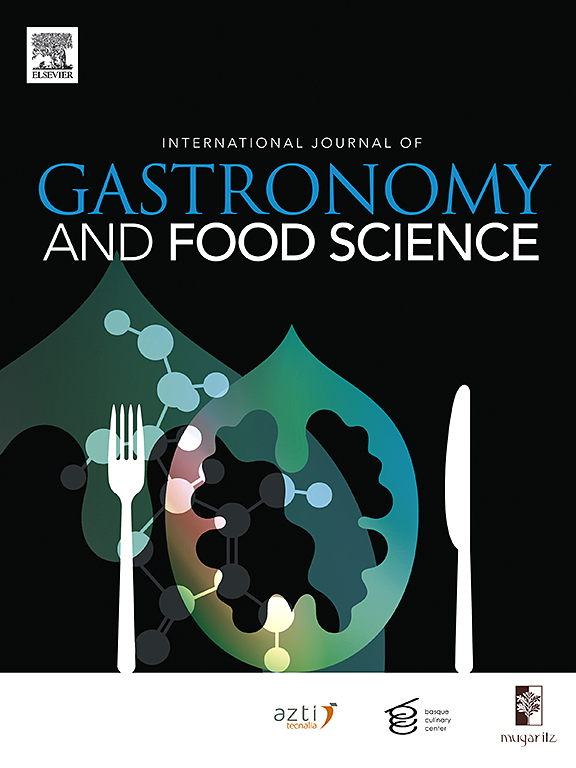从购买到盛盘:阿拉伯联合酋长国家庭厨房中生家禽的安全处理
IF 3.6
2区 农林科学
Q2 FOOD SCIENCE & TECHNOLOGY
International Journal of Gastronomy and Food Science
Pub Date : 2025-05-23
DOI:10.1016/j.ijgfs.2025.101208
引用次数: 0
摘要
食源性疾病仍然是一项全球公共卫生挑战,家庭厨房是病原体传播给消费者的关键点。家禽处理方法,特别是在文化多样化的环境中,会影响食品安全和烹饪传统。本研究调查了阿拉伯联合酋长国(UAE)消费者报告的与购买、处理和准备生鸡肉有关的做法,阿联酋是一个独特的美食景观,融合了中东、亚洲和西方烹饪传统的国家。对425名阿联酋居民进行了横断面调查,以评估与潜在污染风险相关的家禽消费频率、首选购买地点和食品处理行为。调查结果表明,超市是主要的家禽来源(82.4%),整尸是最受欢迎的购买选择(45.2%)。绝大多数人(97.6%)报告在烹饪前冲洗生鸡肉,尽管它在交叉污染中起着众所周知的作用。此外,79.5%的人使用了除水以外的物质,如醋、盐或柠檬,这反映了文化食品制备规范。手卫生习惯各不相同,87.8%的人在处理生家禽后用肥皂和水洗手,75.5%的人使用单独的砧板处理生肉和其他食材。多变量logistic回归分析显示,人口因素,特别是居住酋长国和教育水平,显著影响家禽安全处理行为(p <;0.05)。这些结果强调了烹饪传统、食品安全知识和消费者行为如何相互交叉,影响烹饪实践和食源性疾病风险。了解这些相互作用对于设计符合文化的食品安全干预措施至关重要,这些干预措施与美食传统保持一致,同时最大限度地减少公共卫生风险。这项研究提供了关于烹饪和食品安全如何在多民族社会融合的重要见解,为决策者和烹饪专业人员提供了在不损害传统制备方法的情况下整合更安全的食品处理实践的信息。本文章由计算机程序翻译,如有差异,请以英文原文为准。
From purchase to Plate: Safe handling of raw poultry in domestic kitchens in United Arab Emirates households
Foodborne illnesses remain a global public health challenge, with domestic kitchens serving as a critical point for pathogen transmission to consumers. Poultry handling practices, particularly in culturally diverse settings, influence both food safety and culinary traditions. This study investigates consumer-reported practices related to purchasing, handling, and preparing raw chicken in the United Arab Emirates (UAE), a country with a unique gastronomic landscape that blends Middle Eastern, Asian, and Western culinary traditions. A cross-sectional survey of 425 UAE residents was conducted to assess the frequency of poultry consumption, preferred purchasing locations, and food handling behaviors associated with potential contamination risks. Findings indicate that supermarkets are the primary poultry source (82.4 %), with whole carcasses being the most preferred purchase choice (45.2 %). The vast majority (97.6 %) reported rinsing raw chicken before cooking, despite its known role in cross-contamination. Additionally, 79.5 % used substances other than water, such as vinegar, salt, or lemon, reflecting cultural food preparation norms. Hand hygiene practices varied, with 87.8 % washing hands with soap and water after handling raw poultry, and 75.5 % using separate cutting boards for raw meat and other ingredients. Multivariable logistic regression analysis revealed that demographic factors, particularly Emirate of residence and education level, significantly influenced safe poultry handling behaviors (p < 0.05). These results highlight how culinary traditions, food safety knowledge, and consumer behaviors intersect, influencing gastronomic practices and foodborne disease risk. Understanding these interactions is essential for designing culturally tailored food safety interventions that align with gastronomic heritage while minimizing public health risks. This study provides critical insights into how gastronomy and food safety converge in a multi-ethnic society, informing both policymakers and culinary professionals on integrating safer food handling practices without compromising traditional preparation methods.
求助全文
通过发布文献求助,成功后即可免费获取论文全文。
去求助
来源期刊

International Journal of Gastronomy and Food Science
Social Sciences-Cultural Studies
CiteScore
5.30
自引率
10.50%
发文量
170
审稿时长
45 days
期刊介绍:
International Journal of Gastronomy and Food Science is a peer-reviewed journal that explicitly focuses on the interface of food science and gastronomy. Articles focusing only on food science will not be considered. This journal equally encourages both scientists and chefs to publish original scientific papers, review articles and original culinary works. We seek articles with clear evidence of this interaction. From a scientific perspective, this publication aims to become the home for research from the whole community of food science and gastronomy.
IJGFS explores all aspects related to the growing field of the interaction of gastronomy and food science, in areas such as food chemistry, food technology and culinary techniques, food microbiology, genetics, sensory science, neuroscience, psychology, culinary concepts, culinary trends, and gastronomic experience (all the elements that contribute to the appreciation and enjoyment of the meal. Also relevant is research on science-based educational programs in gastronomy, anthropology, gastronomic history and food sociology. All these areas of knowledge are crucial to gastronomy, as they contribute to a better understanding of this broad term and its practical implications for science and society.
 求助内容:
求助内容: 应助结果提醒方式:
应助结果提醒方式:


